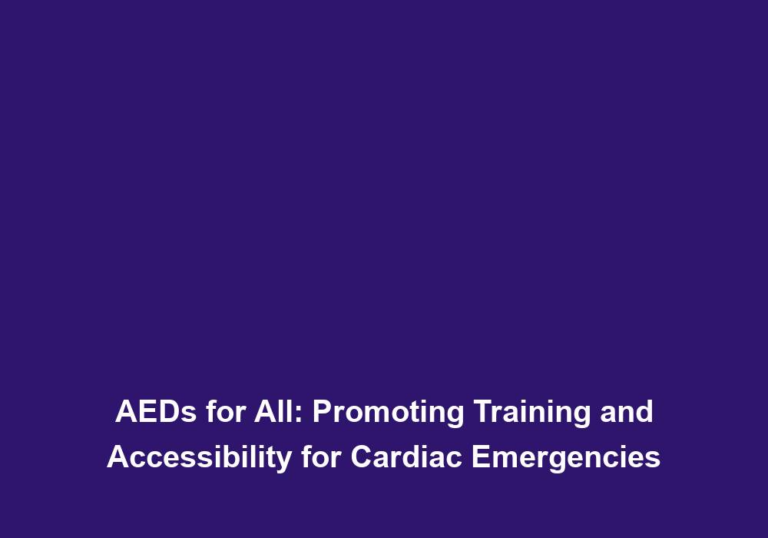Stronger Hearts: How Weight Training Elevates Cardio Fitness
In recent years, weight training has gained immense popularity among fitness enthusiasts. While many may associate weight training with building muscles and increasing strength, it is often overlooked as an effective tool for improving cardiovascular fitness. Contrary to popular belief, cardiovascular exercise is not limited to running or cycling; weight training can also significantly contribute to a healthier heart and enhanced cardiovascular capacity. In this article, we will explore how weight training can elevate cardio fitness and the numerous benefits it offers.
Understanding Cardiovascular Fitness
Before delving into the impact of weight training on cardiovascular fitness, it is crucial to grasp the concept of cardiovascular fitness. Cardiovascular fitness refers to the ability of the heart, blood vessels, and lungs to efficiently supply oxygenated blood to the muscles during physical activity. It plays a vital role in overall health, as it helps strengthen the heart muscle, lowers blood pressure, improves circulation, and reduces the risk of various cardiovascular diseases.
Cardiovascular fitness is not limited to endurance activities like running or cycling. Weight training, which primarily focuses on building strength and muscle, can also have a significant impact on cardiovascular fitness. By engaging in weight training exercises, individuals can elevate their heart rate, improve circulation, and enhance their overall cardiovascular capacity.
The Synergistic Relationship: Weight Training and Cardiovascular Fitness
Weight training involves performing exercises that target specific muscle groups using resistance, such as dumbbells, barbells, or resistance machines. While the primary aim of weight training is to increase muscle size and strength, it also has a profound impact on cardiovascular fitness. Here’s how weight training and cardiovascular fitness work together synergistically:
1. Increased Heart Rate
During weight training exercises, the heart rate increases significantly. This elevated heart rate places a greater demand on the cardiovascular system, forcing it to work harder to supply oxygenated blood to the working muscles. This increased workload strengthens the heart muscle and improves its efficiency, ultimately leading to an enhanced cardiovascular capacity.
When engaging in weight training, the heart rate typically reaches a level that is beneficial for cardiovascular fitness. This sustained increase in heart rate helps improve cardiovascular endurance and trains the heart to efficiently pump blood throughout the body. As a result, individuals who incorporate weight training into their exercise routine can experience a stronger and more resilient heart.
2. Improved Circulation
Weight training promotes better circulation throughout the body, as it requires the heart to pump blood more efficiently. This improved circulation ensures that oxygen and nutrients are delivered to the muscles, aiding in their growth and repair. Additionally, better circulation helps remove waste products, such as lactic acid, from the muscles, reducing the risk of muscle soreness and fatigue.
When engaging in weight training, the muscles require an increased supply of oxygen and nutrients to support their growth and recovery. The improved circulation resulting from weight training ensures that these essential resources are efficiently delivered to the muscles. This not only enhances muscle development but also improves overall cardiovascular health.
3. Reduced Resting Heart Rate
Regular weight training can lead to a lower resting heart rate. A lower resting heart rate indicates that the heart is healthier and more efficient, as it requires less effort to pump blood throughout the body. This reduction in resting heart rate not only improves cardiovascular fitness but also lowers the risk of heart-related conditions, such as heart attacks and strokes.
A lower resting heart rate is a sign of improved cardiovascular fitness. When the heart is stronger and more efficient, it can effectively pump blood with each beat, resulting in a lower resting heart rate. Individuals who engage in regular weight training often experience a decrease in their resting heart rate, indicating that their heart is functioning optimally.
4. Increased Cardiac Output
Cardiac output refers to the amount of blood pumped by the heart per minute. Weight training increases cardiac output by strengthening the heart muscle, allowing it to pump more blood with each contraction. This increased cardiac output ensures that oxygen and nutrients are efficiently transported to the muscles during physical activity, enhancing overall cardiovascular fitness.
Weight training helps the heart become more efficient at pumping blood, resulting in an increased cardiac output. This means that with each beat, the heart can pump a larger volume of blood, ensuring that the muscles receive an adequate supply of oxygen and nutrients. By improving cardiac output, weight training enhances cardiovascular fitness and supports optimal muscle function.
5. Enhanced Endurance
Weight training builds muscular endurance, enabling individuals to perform daily activities with less fatigue. This increased muscular endurance directly translates to improved cardiovascular endurance, as the heart and lungs can sustain physical activity for longer periods without becoming exhausted. Whether it’s climbing stairs, carrying groceries, or participating in sports, weight training enhances endurance and makes everyday tasks easier.
Muscular endurance, which is developed through weight training, has a direct impact on cardiovascular endurance. As the muscles become stronger and more fatigue-resistant, the heart and lungs can sustain physical activity for longer periods without experiencing excessive fatigue. This enhanced endurance not only improves overall fitness but also makes everyday tasks more manageable.
Integrating Weight Training into Your Cardiovascular Fitness Routine
To maximize the benefits of weight training on cardiovascular fitness, it is essential to incorporate it into your exercise routine strategically. Here are some tips to help you integrate weight training effectively:
- Warm-up: Prior to weight training, ensure you warm up your muscles and increase your heart rate by engaging in light cardio exercises such as jogging or jumping jacks. This prepares your body for the upcoming workout and reduces the risk of injury.
Incorporating a proper warm-up before weight training is crucial for preparing the body for the upcoming workout. Engaging in light cardio exercises, such as jogging or jumping jacks, can help increase the heart rate and warm up the muscles. This not only reduces the risk of injury but also primes the cardiovascular system for the demands of weight training.
- Choose Compound Exercises: Incorporate compound exercises into your weight training routine. Compound exercises engage multiple muscle groups simultaneously, increasing the demand on your cardiovascular system. Examples of compound exercises include squats, deadlifts, bench presses, and lunges.
Incorporating compound exercises into your weight training routine can have a significant impact on cardiovascular fitness. These exercises engage multiple muscle groups simultaneously, which increases the demand on the cardiovascular system. Compound exercises such as squats, deadlifts, bench presses, and lunges require the heart to work harder to supply oxygenated blood to the working muscles, resulting in improved cardiovascular endurance.
- Cardiovascular Intervals: Integrate short bursts of cardiovascular exercise, such as jumping rope or cycling, between weightlifting sets. This technique, known as cardiovascular interval training, elevates your heart rate, intensifying the cardiovascular benefits of weight training.
Incorporating cardiovascular intervals into your weight training routine can further enhance the cardiovascular benefits. By engaging in short bursts of cardiovascular exercise, such as jumping rope or cycling, between weightlifting sets, you can elevate your heart rate and intensify the cardiovascular demands of the workout. This technique, known as cardiovascular interval training, helps maximize the cardiovascular benefits of weight training.
- Progressive Overload: Gradually increase the intensity of your weight training sessions by adding more resistance or repetitions over time. This progressive overload stimulates further cardiovascular adaptations, ensuring continuous improvement in your fitness levels.
Implementing progressive overload in your weight training program is crucial for continuous improvement in cardiovascular fitness. By gradually increasing the intensity of your weight training sessions, either by adding more resistance or repetitions, you can stimulate further cardiovascular adaptations. This progressive overload challenges the cardiovascular system, leading to continuous improvements in cardiovascular fitness.
- Rest and Recovery: Allow your body sufficient time to rest and recover between weight training sessions. Adequate rest is crucial for optimizing cardiovascular fitness and preventing overuse injuries.
Proper rest and recovery are vital components of any exercise routine, including weight training. Allowing your body sufficient time to rest and recover between weight training sessions is crucial for optimizing cardiovascular fitness. Adequate rest ensures that the cardiovascular system can fully recover and adapt to the demands of weight training, reducing the risk of overuse injuries and promoting overall cardiovascular health.
Conclusion
Weight training is not solely limited to building muscle and strength; it can also play a significant role in improving cardiovascular fitness. By incorporating weight training into your exercise routine strategically, you can strengthen your heart, enhance circulation, and boost your overall cardiovascular capacity. Remember to consult with a fitness professional or personal trainer to develop a tailored weight training program that suits your fitness goals and abilities. So, embrace the power of weight training and experience the incredible benefits it offers for your cardiovascular health.







